Computational Estimate of the Initial Damage Effect on the Fatigue Strength of Composite Materials
Abstract
:1. Introduction
2. Description of the Calculation Methodology
- Preparation of the model by the user;
- Calculation using the static solver Samcef module with the Mecano module (first iteration).
- Fatigue analysis is performed using the Durability module;
- Model of damage accumulation in the layer under quasi-static load application;
- Prediction of the onset of delamination-type damage.
- Damageability is determined;
- The equivalent plastic strain is determined;
- The equivalent stresses are determined;
- The dependence of equivalent stresses on equivalent plastic strains is plotted.
3. Results of Static Calculations and Comparison with Experimental Data
4. Results of Fatigue Calculations and Comparison with Experimental Data
5. Conclusions
Author Contributions
Funding
Data Availability Statement
Conflicts of Interest
References
- Reifsnider, K.L. Life prediction analysis: Directions and divagations. In Proceedings of the Sixth International Conference on Composite Materials and Second European Conference on Composite Materials (ICCM & ECCM), Proceedings, London, UK, 20–24 July 1987; Matthews, F.L., Buskell, N.C.R., Hodgkinson, J.M., Morton, J., Eds.; Elsevier: Amsterdam, The Netherlands, 1987; Volume 4, pp. 4.1–4.31. [Google Scholar]
- Harris, B. Fatigue Behaviour of Polymer-Based Composites and Life Prediction Methods; Nationaal Fonds voor Wetenschappelijk Onderzoek: Brussels, Belgium, 1995. [Google Scholar]
- Hahn, H.T.; Kim, R.Y. Fatigue behaviour of composite laminates. J. Compos. Mat. 1976, 10, 156–180. [Google Scholar] [CrossRef]
- Schaff, J.R.; Davidson, B.D. Life prediction methodology for composite structures. Part I—Constant amplitude and two-stress level fatigue. J. Compos. Mat. 1997, 31, 128–157. [Google Scholar] [CrossRef]
- Allen, D.H.; Highsmith, A.L.; Lo, D.C. A continuum damage mechanics model for life prediction of laminated composites. In Durability of Polymer Based Composite Systems for Structural Applications, Proceedings of the International Colloquium, Brussels, Belgium, 27–31 August 1990; Cardon, A.H., Verchery, G., Eds.; Elsevier: Amsterdam, The Netherlands, 1990; pp. 119–128. [Google Scholar]
- Daniel, I.M.; Charewicz, A. Fatigue damage mechanisms and residual properties of graphite/epoxy laminates. Eng. Fract. Mech. 1986, 25, 793–808. [Google Scholar] [CrossRef]
- Hwang, W.; Han, K.S. Cumulative damage models and multi-stress fatigue life prediction. J. Compos. Mat. 1986, 20, 125–153. [Google Scholar] [CrossRef]
- Shokrieh, M.M.; Lessard, L.B. Progressive fatigue damage modeling of composite materials, Part I: Modeling. J. Compos. Mat. 2000, 34, 1056–1080. [Google Scholar] [CrossRef]
- Highsmith, A.L.; Reifsnider, K.L. Stiffness-reduction mechanisms in composite laminates. In Damage in Composite Materials; Reifsnider, K.L., Ed.; ASTM STP 775; American Society for Testing and Materials: West Conshohocken, PA, USA, 1982; pp. 103–117. [Google Scholar]
- Talreja, R. Fatigue damage evolution in composites—A new way forward in modeling. In Proceedings of the Second International Conference on Fatigue of Composites, Williamsburg, VA, USA, 4–7 June 2000; p. 9.1. [Google Scholar]
- Ryabov, A.A.; Voronkov, O.V.; Suhov, S.V.; Strelets, D.Y.; Slobodchikov, V.G. Numerical and experimental investigations of compressed stiffened composite panel with local impact damage. Aerosp. Syst. 2018, 1, 99–107. [Google Scholar] [CrossRef]
- Kondakov, I.; Chernov, A.; Guseva, N.; Levchenkov, M. Protective elements for lattice composite fuselage structures against low-velocity impacts. Aerosp. Syst. 2022, 5, 1–9. [Google Scholar] [CrossRef]
- Paepegem, W. Development and Finite Element Implementation of a Damage Model for Fatigue of Fibre-Reinforced Polymers; Ghent University Architectural and Engineering Press: Ghent, Belgium, 2002. [Google Scholar]
- Talreja, R. Damage mechanics of composite materials based on thermodynamics with internal variables. In Durability of Polymer Based Composite Systems for Structural Applications, Proceedings of the International Colloquium, Brussels, Belgium, 27–31 August 1990; Cardon, A.H., Verchery, G., Eds.; Elsevier: Amsterdam, The Netherlands, 1990; pp. 65–79. [Google Scholar]
- El Mahi, A.; Berthelot, J.-M.; Brillaud, J. Stiffness reduction and energy release rate of cross-ply laminates during fatigue tests. Compos. Struct. 1995, 30, 123–130. [Google Scholar] [CrossRef]
- Ladeveze, P. A damage approach for composite structures: Theory and identification. In Mechanical Identification of Composites, Proceedings of the the European Mechine Colloquium 269, Saint-Etienne, France, 3–6 December 1990; Vautrin, A., Sol, H., Eds.; Elsevier: Amsterdam, The Netherlands, 1990; pp. 44–57. [Google Scholar]
- Sidoroff, F.; Subagio, B. Fatigue damage modelling of composite materials from bending tests. In Proceedings of the Sixth International Conference on Composite Materials and Second European Conference on Composite Materials (ICCM & ECCM), Proceedings, London, UK, 20–24 July 1987; Matthews, F.L., Buskell, N.C.R., Hodgkinson, J.M., Morton, J., Eds.; Elsevier: Amsterdam, The Netherlands, 1987; Volume 4, pp. 4.32–4.39. [Google Scholar]
- Kawai, M. Damage mechanics model for off-axis fatigue behavior of unidirectional carbon fiber-reinforced composites at room and high temperatures. In Proceedings of the Twelfth International Conference on Composite Materials (ICCM-12), Paris, France, 5–9 July 1999; p. 322. [Google Scholar]
- Allix, O.; Ladevèze, P. Interlaminar interface modelling for the prediction of delamination. Compos. Struct. 1992, 22, 235–242. [Google Scholar] [CrossRef]
- Prinz, R. Damage rates for interlaminar failure of fatigue CFRP laminates. In Developments in the Science and Technology of Composite Materials, Proceedings of the Fourth European Conference on Composite Materials (ECCM/4), Stuttgart, Germany, 25–28 September 1990; Füller, J., Grüninger, G., Schulte, K., Bunsell, A.R., Massiah, A., Eds.; Elsevier Applied Science: Amsterdam, The Netherlands, 1990; pp. 189–193. [Google Scholar]
- Vieillevigne, S.; Jeulin, D.; Renard, J.; Sicot, N. Modelling of the fatigue behaviour of a unidirectional glass epoxy composite submitted to fatigue loadings. In Proceedings of the International Conference on Fatigue of Composites, Proceedings, Paris, France, 3–5 June 1997; Degallaix, S., Bathias, C., Fougères, R., Eds.; La Société Française de Métallurgie et de Matériaux: Paris, France, 1997; pp. 424–430. [Google Scholar]
- Phillips, E.P. Effects of Truncation of a Predominantly Compression Load Spectrum on the Life of a Notched Graphite/Epoxy Laminate; ASTM International: West Conshohocken, PA, USA, 1979. [Google Scholar]
- Boisse, P.; Hamila, N.; Madeo, A. Modelling the development of defects during composite reinforcements and prepreg forming. Philos. Trans. R. Soc. A Math. Phys. Eng. Sci. 2016, 347, 20150269. [Google Scholar] [CrossRef] [PubMed]
- Dimitrienko, Y.I.; Yurin, Y.V. Multiscale Simulation of Multilayer Thin Composite Plates with Solitary Defects. Math. Model. Numer. Methods 2016. [Google Scholar]
- Shalimov, A.S.; Tashkinov, M.A. Simulation of crack growth in porous materials using finite elements with additional degrees of freedom. Math. Model. Nat. Sci. 2018. [Google Scholar]
- Anoshkin, A.N.; Zuiko, V.; Yu Osokin, V.M.; Tretyakov, A.A.; Pisarev, P.V. Modeling of technological defects and evaluation of their influence on the static strength of composite flanges. Mater. Sci. 2016. [Google Scholar]
- Dimitrienko, Y.I.; Yuri, Y.V. Finite Element Modeling of Damage and Durability of Composite Structural Elements with Lamination-Type Defects. Math. Model. Numer. Methods 2017. [Google Scholar]
- Ferté, G.; Massin, P.; Moes, N. 3D crack propagation with cohesive elements in the extended finite element method. Comput. Methods Appl. Mech. Eng. 2016, 300, 347–374. [Google Scholar] [CrossRef]
- Kurumatani, M.; Soma, Y.; Terada, K. Simulations of cohesive fracture behavior of reinforced concrete by a fracturemechanics-based damage model. Eng. Fract. Mech. 2019, 206, 392–407. [Google Scholar] [CrossRef]
- Li, H.; Yuan, H.; Li, X. Assessment of low cycle fatigue crack growth under mixed-mode loading conditions by using a cohesive zone mode. Int. J. Fatigue 2015, 75, 39–50. [Google Scholar] [CrossRef]
- Li, H.; Yuan, H. Cohesive zone modelling of low cycle fatigue cracks in cracked and notched specimens. Fatigue Fract. Eng. Mater. Struct. 2013, 36, 1246–1257. [Google Scholar] [CrossRef]
- Li, X.; Chen, J. An extended cohesive damage model for simulating arbitrary damage propagation in engineering materials. Comput. Methods Appl. Mech. Eng. 2017, 315, 744–759. [Google Scholar] [CrossRef]
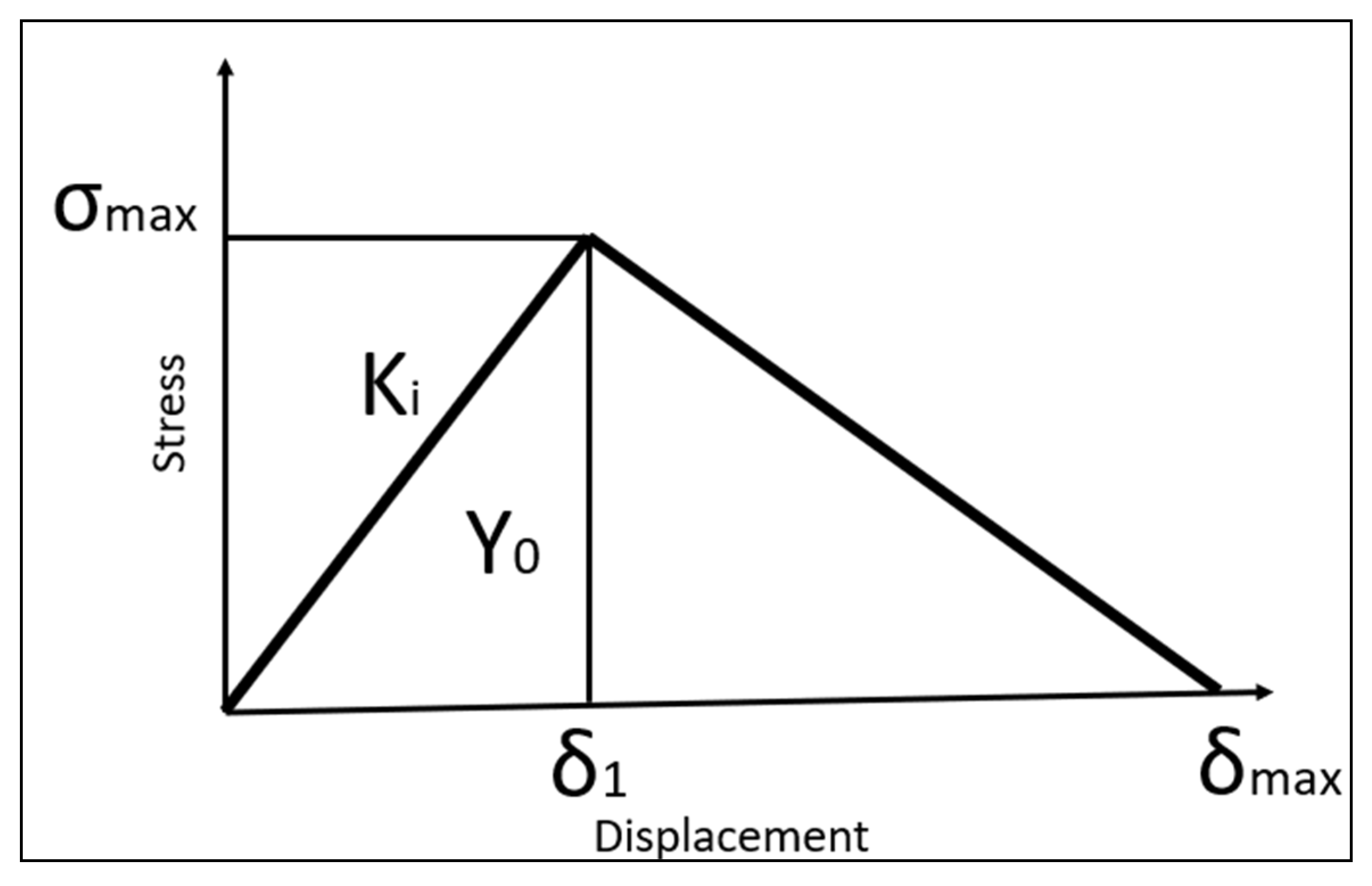


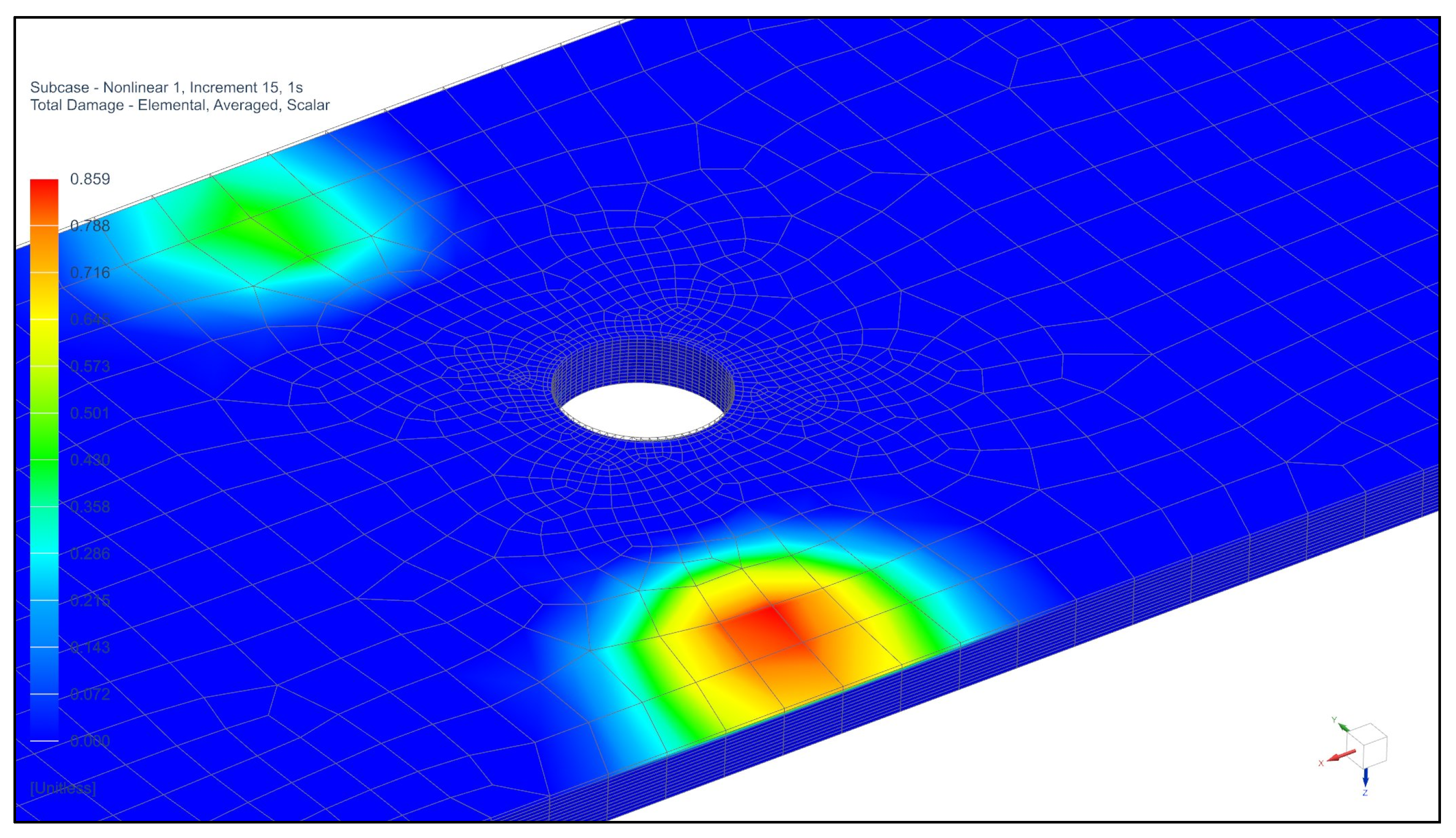
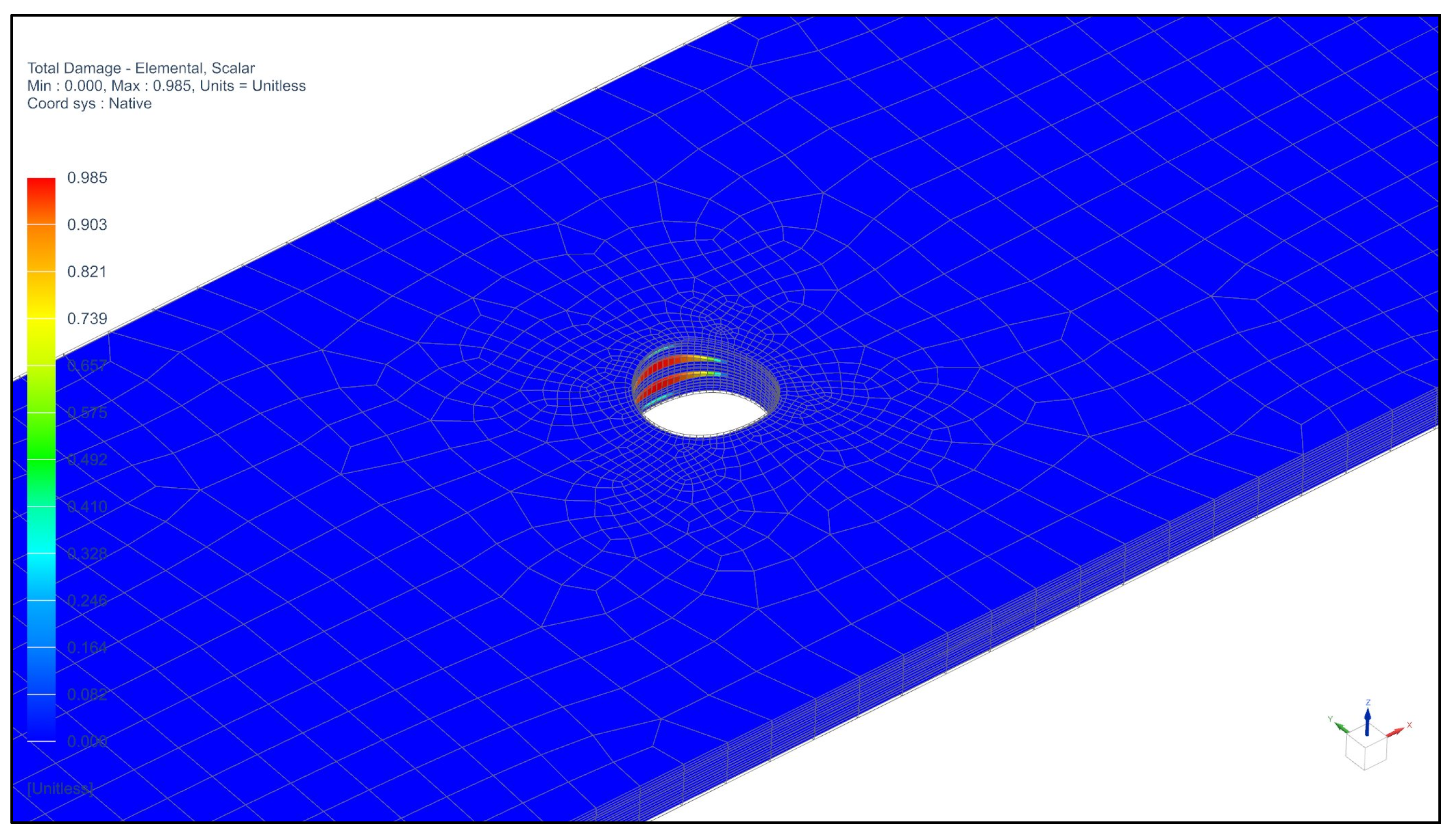
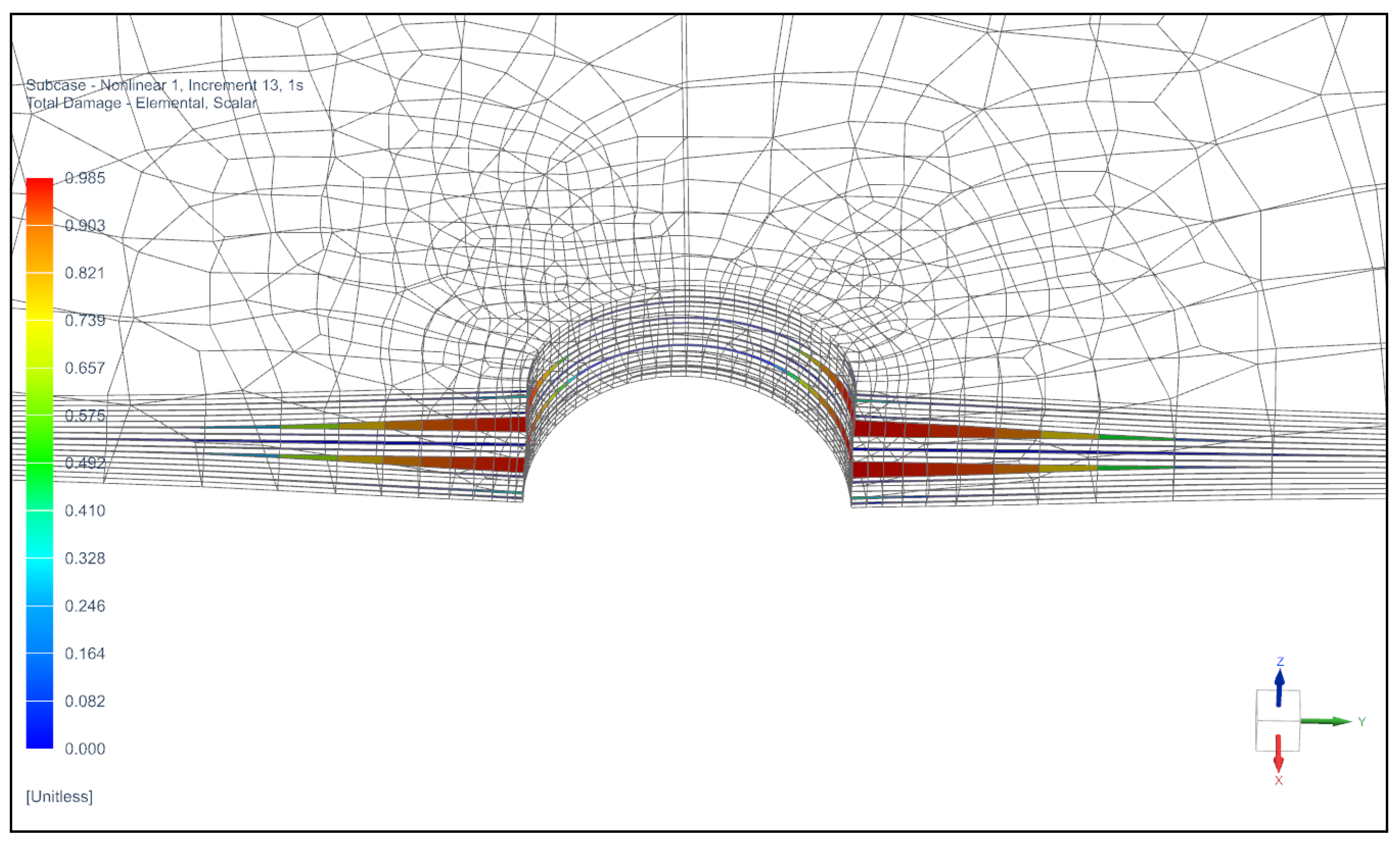
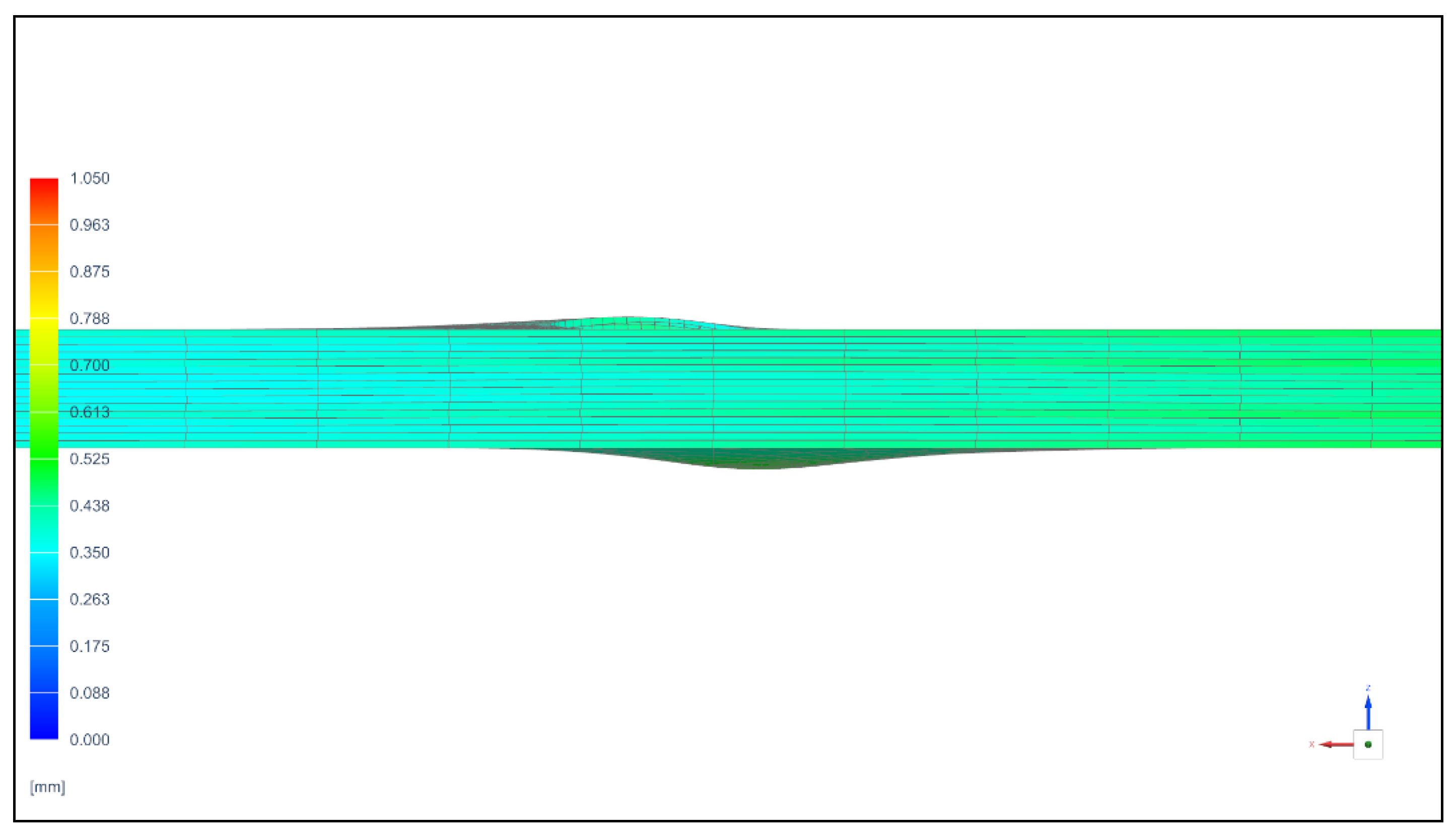
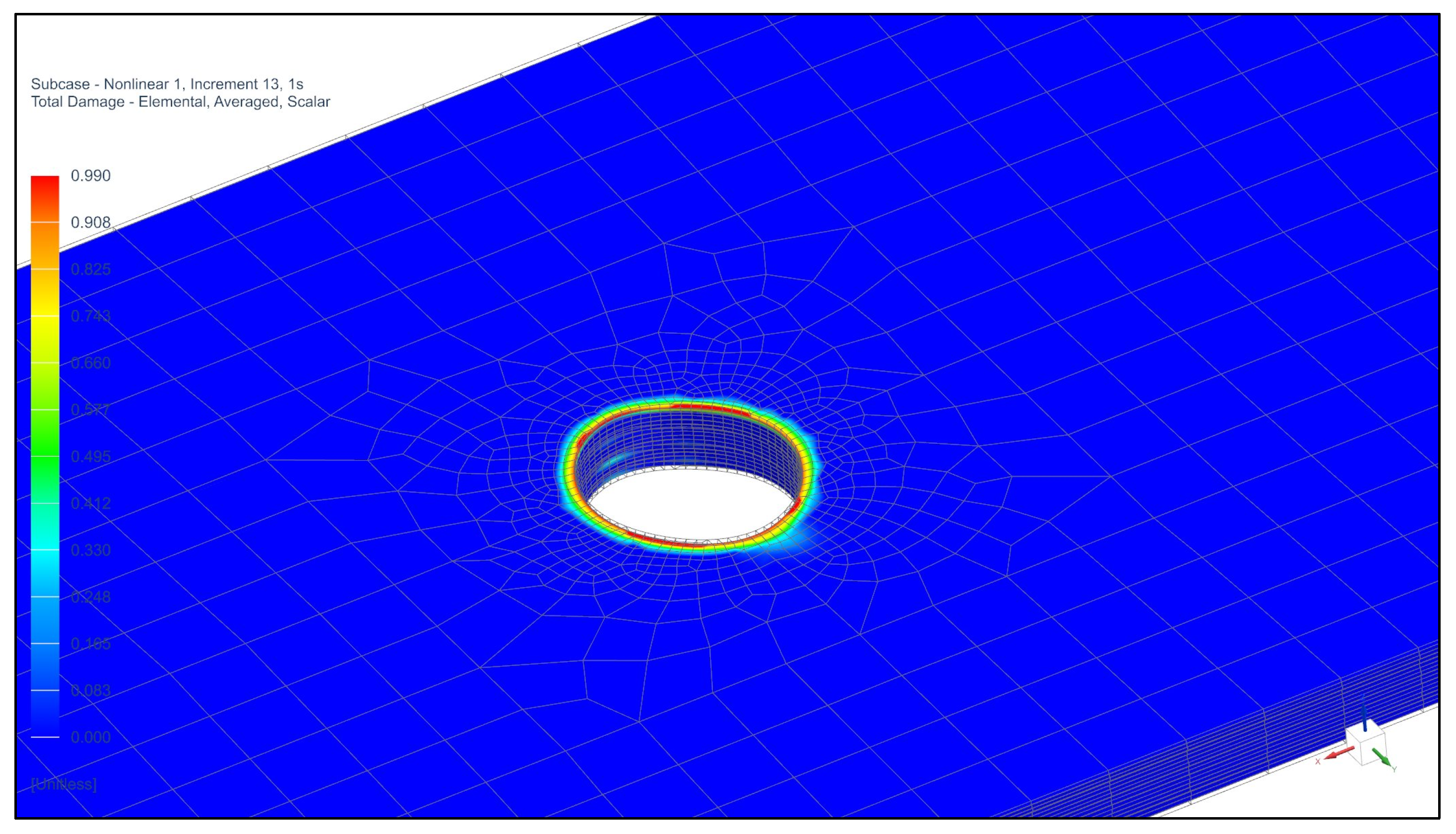
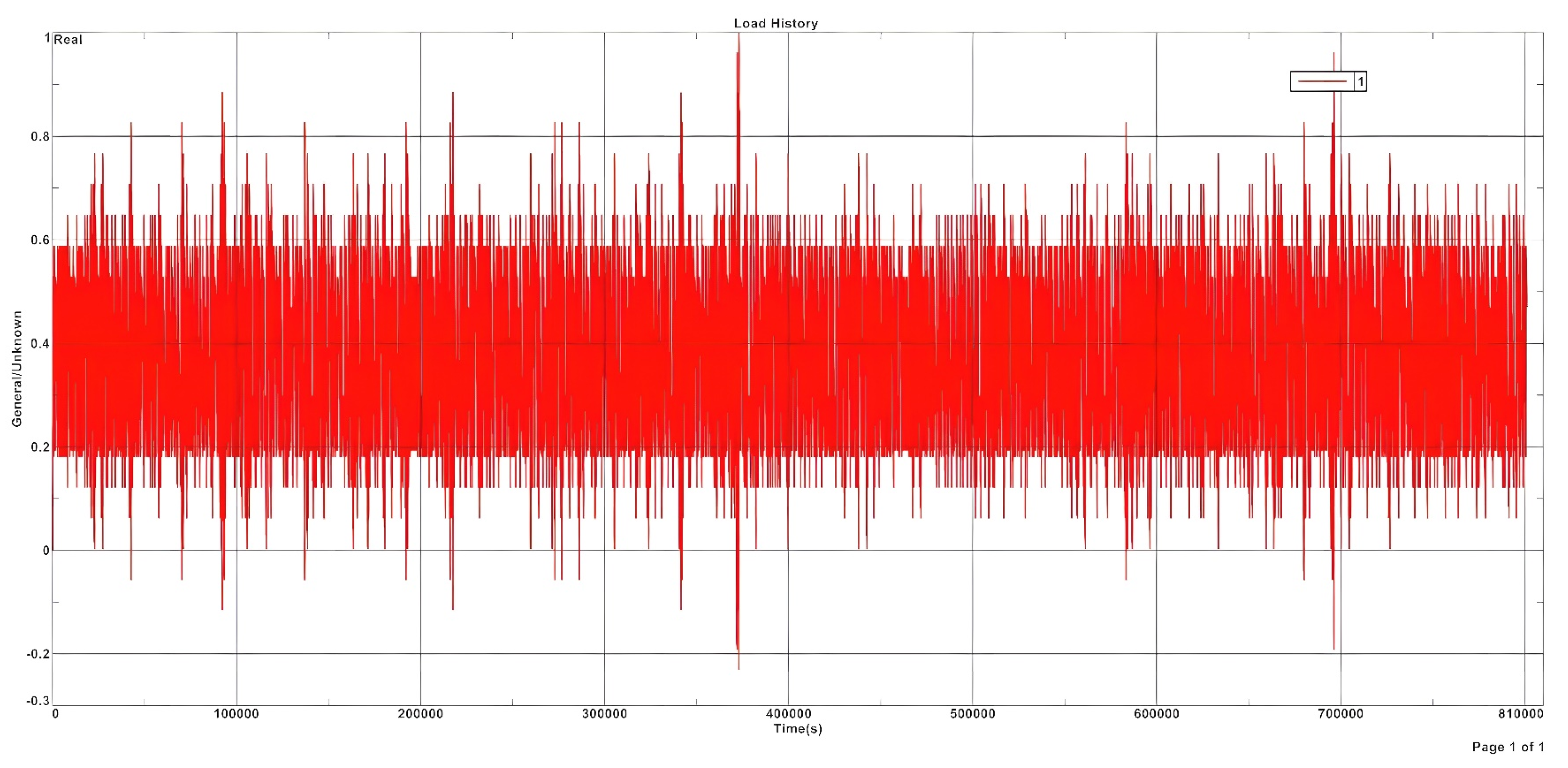
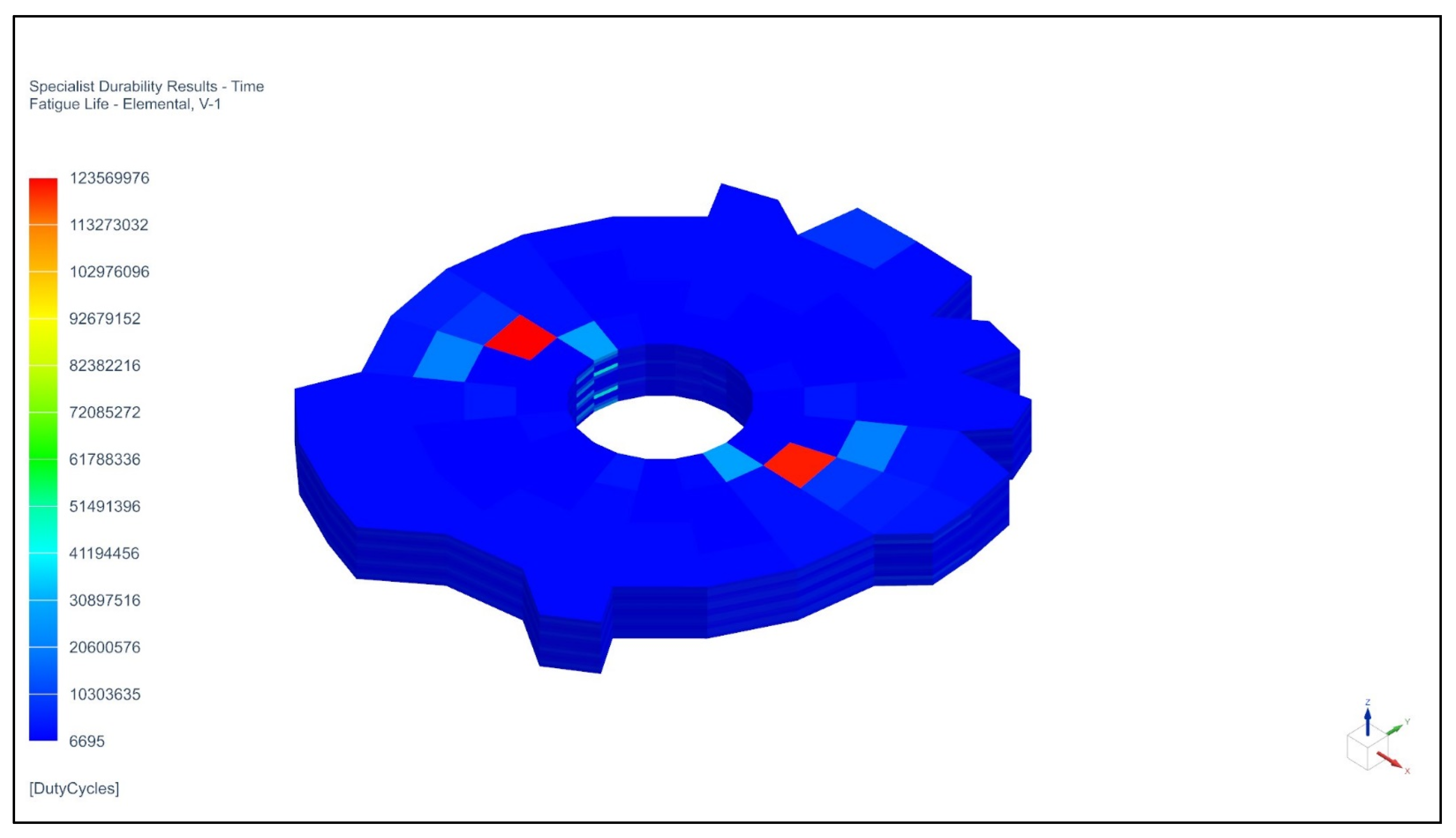


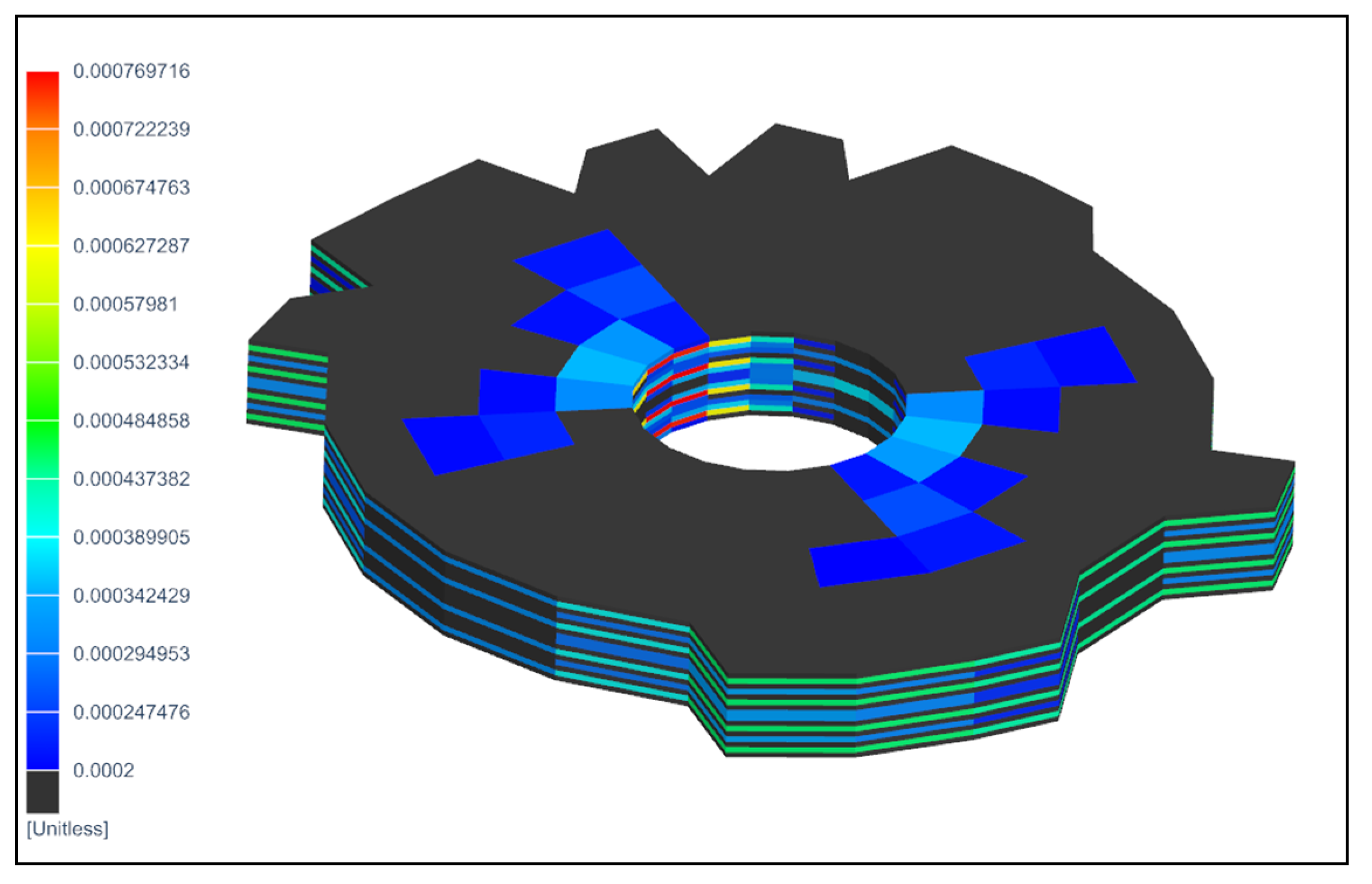

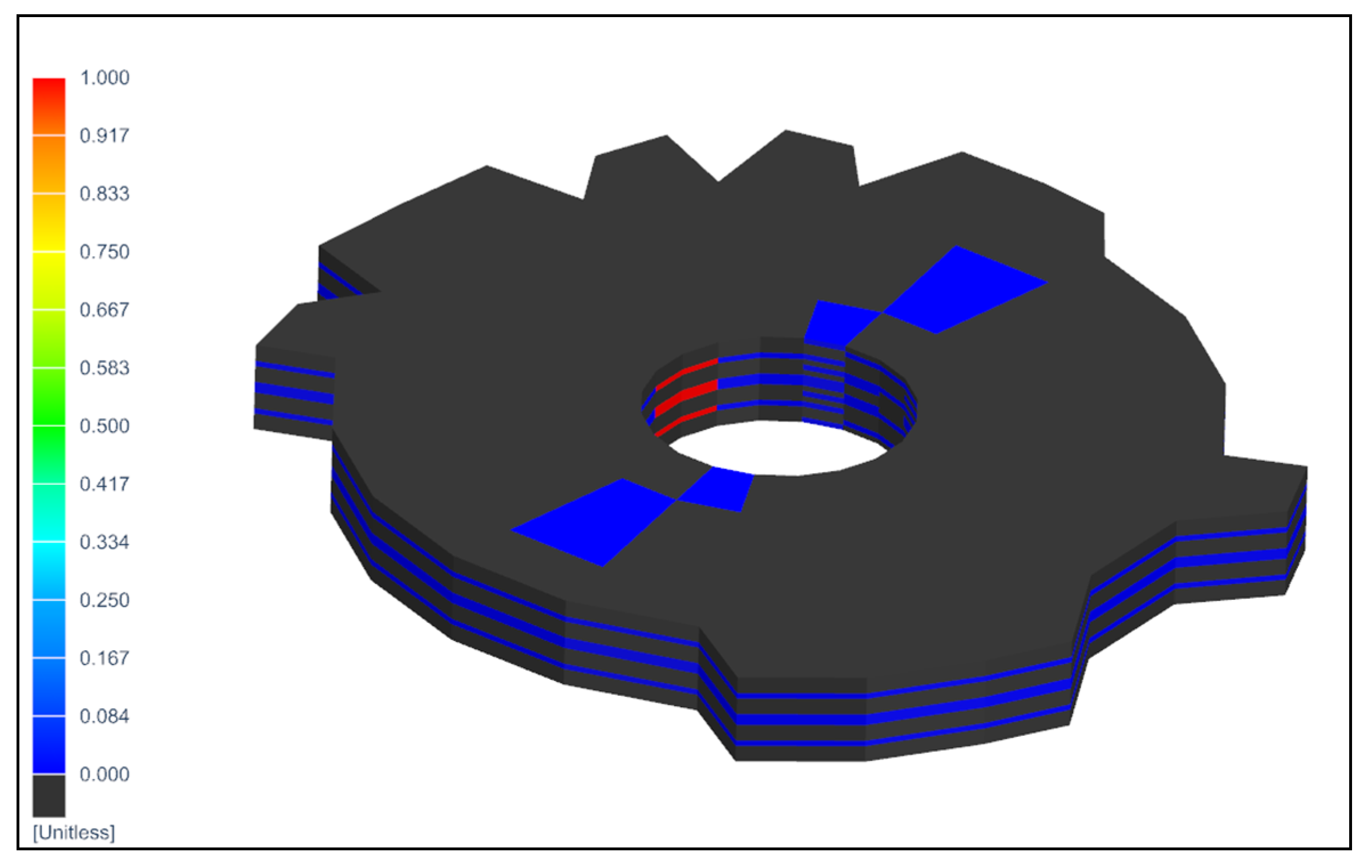
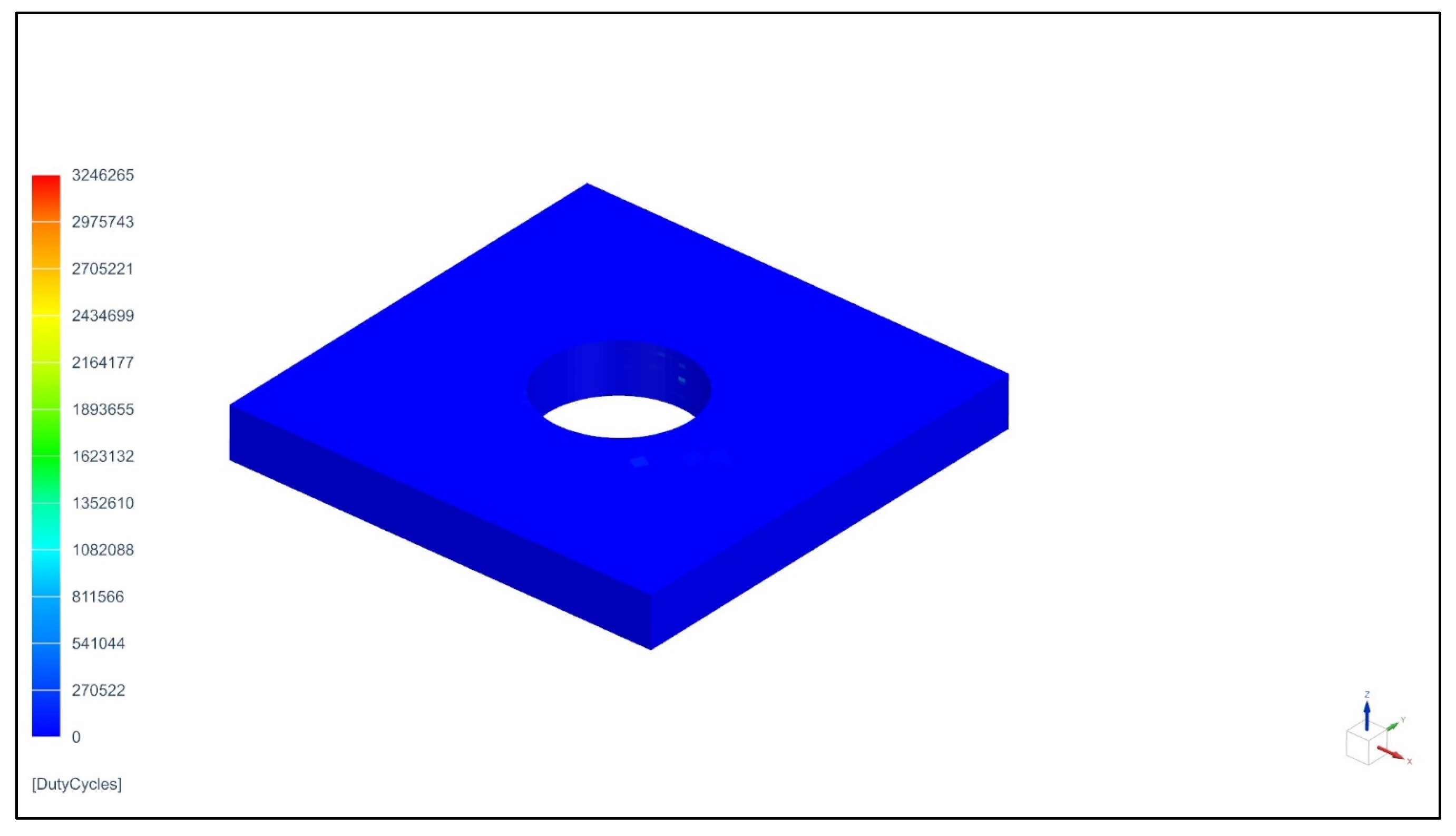

| Calculation Case | Loss of Stability after Static Calculation | Damage Accumulation |
|---|---|---|
| Sample with 19 mm × 19 mm frame without defect | No | 0.274 |
| Sample with 19 mm × 19 mm frame with defect | Loss of stability in the hole area | 0.990 (0.908—excluding damage from an entered defect) |
| Sample with 32 mm × 32 mm frame without defect | Loss of stability in the hole area | 0.985 |
| Sample with 32 mm × 32 mm frame with defect | Loss of stability in the hole area | 0.990 (0.908—excluding damage from an entered defect) |
| Experiment | Calculation | ||
|---|---|---|---|
| Full TWIST program | |||
| Blocks (intervals on the cyclogram) | 22 | 16 | Calculation end criterion fulfilled |
| Flight (number of cycles) | 61,655 61,655 65,655 165,000 Average 88,491.25 | 64,000 | |
| Zero-compression cycles , minimum stress −248 MPa | |||
| Cycles | 15,924 78,132 | 60,000 | Calculation end criterion fulfilled |
| Asymmetric cycles with dominant compression , minimum stress −248 MPa | |||
| Cycles | 1939 2710 8141 | 6695 | Calculation end criterion fulfilled |
| , −248 MPa | , −248 MPa | ||
|---|---|---|---|
| Maximum fiber failure strain D11, % | 0.047% | 0.077% | 1.638 |
| Maximum matrix failure—cracking strain D22, % | 0.058% | 100% | 1724.13 |
| Maximum matrix failure—fiber delamination from matrix strain D12, % | 100% | 100% | 1 |
| Calculation without Initial Damage | Calculation with Initial Damage | ||
|---|---|---|---|
| Full TWIST program | |||
| Blocks (intervals on the cyclogram | 16 | 16 | Calculation end criterion not fulfilled |
| Flights (number of cycles) | 6695 | 0 | |
Disclaimer/Publisher’s Note: The statements, opinions and data contained in all publications are solely those of the individual author(s) and contributor(s) and not of MDPI and/or the editor(s). MDPI and/or the editor(s) disclaim responsibility for any injury to people or property resulting from any ideas, methods, instructions or products referred to in the content. |
© 2023 by the authors. Licensee MDPI, Basel, Switzerland. This article is an open access article distributed under the terms and conditions of the Creative Commons Attribution (CC BY) license (https://creativecommons.org/licenses/by/4.0/).
Share and Cite
Shramko, K.K.; Kononov, N.O.; Lutoshkina, A.E.; Shadrinov, A.V. Computational Estimate of the Initial Damage Effect on the Fatigue Strength of Composite Materials. J. Compos. Sci. 2023, 7, 438. https://doi.org/10.3390/jcs7100438
Shramko KK, Kononov NO, Lutoshkina AE, Shadrinov AV. Computational Estimate of the Initial Damage Effect on the Fatigue Strength of Composite Materials. Journal of Composites Science. 2023; 7(10):438. https://doi.org/10.3390/jcs7100438
Chicago/Turabian StyleShramko, Konstantin Konstantinovich, Nikolai Olegovich Kononov, Arina Evgenevna Lutoshkina, and Aleksey Viktorovich Shadrinov. 2023. "Computational Estimate of the Initial Damage Effect on the Fatigue Strength of Composite Materials" Journal of Composites Science 7, no. 10: 438. https://doi.org/10.3390/jcs7100438
APA StyleShramko, K. K., Kononov, N. O., Lutoshkina, A. E., & Shadrinov, A. V. (2023). Computational Estimate of the Initial Damage Effect on the Fatigue Strength of Composite Materials. Journal of Composites Science, 7(10), 438. https://doi.org/10.3390/jcs7100438





